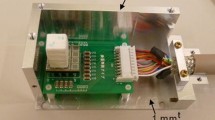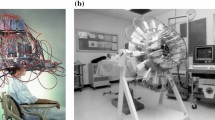Abstract
To increase spatial resolution and signal-to-noise ratio in PET imaging, we present in this paper the design and performance evaluation of a PET detector module combining both depth-of-interaction (DOI) and time-of-flight (TOF) capabilities. The detector module consists of a staggered dual-layer LYSO block with 2 mm × 2 mm × 7 mm crystals. MR-compatible SiPM sensors (MicroFJ-30035-TSV, SensL) are assembled into an 8 × 8 array. SiPM signals from both fast and slow outputs are read out by a 128-channel ASIC chip. To test its performance, a flood histogram is acquired with a 22Na point source on top of the detector, and the energy resolution and the coincidence resolving time (CRT) value for each individual crystal are measured. The flood histogram shows excellent crystal separation in both layers. The average energy resolution at 511 keV is 14.0 and 12.7% at the bottom and top layers, respectively. The average CRT of a single crystal is 635 and 565 ps at the bottom and top layers, respectively. In conclusion, the compact DOI–TOF PET detector module is of excellent crystal identification capability, good energy resolution and reasonable time resolution and has promising application prospective in clinical TOF PET, PET/MRI, and brain PET systems.






Similar content being viewed by others
References
G. Delso, S. Fürst, B. Jakoby et al., Performance measurements of the Siemens mMR integrated whole-body PET/MR scanner. J. Nucl. Med. 52, 1914–1922 (2011). doi:10.2967/jnumed.111.092726
E. Roncali, S.R. Cherry, Application of silicon photomultipliers to positron emission tomography. Ann. Biomed. Eng. 39, 1358–1377 (2011). doi:10.1007/s10439-011-0266-9
H.S. Yoon, G.B. Ko, S.I. Kwon et al., Initial results of simultaneous PET/MRI experiments with an MRI-compatible silicon photomultiplier PET scanner. J. Nucl. Med. 53, 608–614 (2012). doi:10.2967/jnumed.111.097501
Y.J. Wang, Z.M. Zhang, D.W. Li et al., Development of a PET insert for simultaneous small animal PET/MRI. EJNMMI Phys. (2015). doi:10.1186/2197-7364-2-S1-A21
C.J. Thompson, A.L. Goertzen, J.D. Thiessen et al., Development of a PET scanner for simultaneously imaging small animals with MRI and PET. Sensors 14, 14654–14671 (2014). doi:10.3390/s140814654
A. Kolb, H.F. Wehrl, M. Hofmann et al., Technical performance evaluation of a human brain PET/MRI system. Eur. Radiol. 22, 1776–1788 (2012). doi:10.1007/s00330-012-2415-4
C. Bauer, A. Stolin, J. Proffitt et al., Development of a ring PET insert for MRI, in IEEE NSS/MIC Conference Record, pp. 1–9 (2013). doi:10.1109/NSSMIC.2013.6829135
Y. Xia, T.Y. Ma, Y.Q. Liu et al., Imaging performance evaluation in depth-of-interaction PET with a new method of sinogram generation: a Monte Carlo simulation study. Nucl. Sci. Tech. 22, 144–150 (2011). doi:10.13538/j.1001-8042/nst.22.144-150
D.R. Schaart, H.T. van Dam, S. Seifert et al., A novel, SiPM-array-based, monolithic scintillator detector for PET. Phys. Med. Biol. 54, 3501–3512 (2009). doi:10.1088/0031-9155/54/11/015
P. Bruyndonckx, S. Léonard, S. Tavernier et al., Neural network-based position estimators for PET detectors using monolithic LSO blocks. IEEE Trans. Nucl. Sci. 51, 2520–2525 (2004). doi:10.1109/TNS.2004.835782
H. Liu, T. Omura, M. Watanabe et al., Development of a depth of interaction detector for γ-rays. Nucl. Instrum. Methods A 459, 182–190 (2001). doi:10.1016/S0168-9002(00)00939-6
Y.P. Shao, X.S. Sun, K.A. Lan et al., Development of a prototype PET scanner with depth-of-interaction measurement using solid-state photomultiplier arrays and parallel readout electronics. Phys. Med. Biol. 59, 1223–1238 (2014). doi:10.1088/0031-9155/59/5/1223
A. Kishimoto, J. Kataoka, T. Kato et al., Development of a dual-sided readout DOI-PET module using large-area monolithic MPPC-arrays. IEEE Trans. Nucl. Sci. 60, 38–43 (2013). doi:10.1109/TNS.2012.2233215
P. Fan, T.Y. Ma, Q.Y. Wei et al., Choice of crystal surface finishing for a dual-ended readout depth-of-interaction (DOI) detector. Phys. Med. Biol. 61, 1041–1066 (2016). doi:10.1088/0031-9155/61/3/1041
J. Seidel, J.J. Vaquero, S. Siegel et al., Depth identification accuracy of a three layer phoswich PET detector module. IEEE Trans. Nucl. Sci. 46, 485–490 (1999). doi:10.1109/23.775567
C.M. Pepin, P. Bérard, A.L. Perrot et al., Properties of LYSO and recent LSO scintillators for phoswich PET detectors. IEEE Trans. Nucl. Sci. 51, 789–795 (2004). doi:10.1109/TNS.2004.829781
M. Conti, State of the art and challenges of time-of-flight PET. Phys. Med. 25, 1–11 (2009). doi:10.1016/j.ejmp.2008.10.001
R. Vinke, H. Löhner, D.R. Schaart et al., Optimizing the timing resolution of SiPM sensors for use in TOF-PET detectors. Nucl. Instrum. Methods A 610, 188–191 (2009). doi:10.1016/j.nima.2009.05.068
C. Jackson, SensL B-Series and C-Series silicon photomultipliers for time-of-flight positron emission tomography. Nucl. Instrum. Methods A 787, 169–172 (2015). doi:10.1016/j.nima.2014.11.087
Sensl.com, J Series (High Performance/TSV)—Datasheet, 2016 May 10. http://sensl.com/documentation. Accessed 21 May 2016. (Online)
T.P. Xu, S. Wang, Q.Y. Wei et al., Development of multi-channel fast SiPM readout electronics for clinical TOF PET detector, in IEEE NSS/MIC Conference Record, pp. 1–3 (2014). doi:10.1109/NSSMIC.2014.7431013
T.P. Xu, J. Wen, Q. Wang et al., A novel sub-millimeter resolution PET detector with TOF capability, in IEEE NSS/MIC Conference Record, pp. 1–5 (2013). doi:10.1109/NSSMIC.2013.6829019
T. Song, H. Wu, S. Komarov et al., A submillimeter resolution PET detector module using a multipixel photon counter array. Phys. Med. Biol. 55, 2573–2587 (2010). doi:10.1109/TNS.2015.2499726
S. Yamamoto, J.Y. Yeom, K. Kamada et al., Development of an ultrahigh resolution block detector based on 0.4 mm pixel Ce: GAGG scintillators and a silicon photomultiplier array. IEEE Trans. Nucl. Sci. 60, 4582–4587 (2013). doi:10.1109/TNS.2013.2282294
Z. Deng, A.K. Lan, X. Sun et al., Development of an eight-channel time-based readout ASIC for PET applications. IEEE Trans. Nucl. Sci. 58, 3212–3218 (2011). doi:10.1109/TNS.2011.2165557
J. Du, Y. Yang, X. Bai et al., Characterization of large-area SiPM array for PET applications. IEEE Trans. Nucl. Sci. 63, 8–16 (2016). doi:10.1109/TNS.2015.2499726
V. Schulz, B. Weissler, P. Gebhard et al., SiPM based preclinical PET/MR insert for a human 3T MR: first imaging experiments, in IEEE NSS/MIC Conference Record, pp. 4467–4469 (2011). doi:10.1109/NSSMIC.2011.6152496
Q.Y. Wei, S. Wang, T.T. Dai et al., SiPM based PET detector modules with air-gapped pixelated LYSO, in IEEE NSS/MIC Conference Record, pp. 1–3 (2014). doi: 10.1109/NSSMIC.2014.7431198
G. Stortz, M.D. Walker, C.J. Thompson et al., Characterization of a new MR compatible small animal PET scanner using Monte-Carlo simulations. IEEE Trans. Nucl. Sci. 60, 1637–1644 (2013). doi:10.1109/TNS.2013.2256927
N. Zhang, C.J. Thompson, D. Togane et al., Anode position and last dynode timing circuits for dual-layer BGO scintillator with PS-PMT based modular PET detectors. IEEE Trans. Nucl. Sci. 49, 2203–2207 (2002). doi:10.1109/TNS.2002.803815
X. Zhang, G. Stortz, V. Sossi et al., Development and evaluation of a LOR-based image reconstruction with 3D system response modeling for a PET insert with dual-layer offset crystal design. Phys. Med. Biol. 58, 8379 (2013). doi:10.1088/0031-9155/58/23/8379
X.Z. Zhu, Z. Deng, Y. Chen et al., Development of a 64-channel readout ASIC for an 8 × 8 SiPM array for PET and TOF-PET applications. IEEE Trans. Nucl. Sci. 63, 1327–1334 (2016). doi:10.1109/TNS.2016.2518808
R.T. Yao, T.Y. Ma, Y.P. Shao, Lutetium oxyorthosilicate (LSO) intrinsic activity correction and minimal detectable target activity study for SPECT imaging with a LSO-based animal PET scanner. Phys. Med. Biol. 53, 4399–4415 (2008). doi:10.1088/0031-9155/53/16/012
Q.Y. Wei, T.T. Dai, T.Y. Ma et al., Crystal identification in dual-layer-offset DOI-PET detectors using stratified peak tracking based on SVD and mean-shift algorithm. IEEE Trans. Nucl. Sci. 63, 2502–2508 (2016). doi:10.1109/TNS.2016.2590505
Q.Y. Wei, S. Wang, T.Y. Ma et al., Performance evaluation of a compact PET/SPECT/CT tri-modality system for small animal imaging applications. Nucl. Instrum. Methods A 786, 147–154 (2015). doi:10.1016/j.nima.2015.03.045
Q.Y. Wei, S. Wang, T.Y. Ma et al., Influence factors of two dimensional position map on photomultiplier detector block designed by quadrant sharing technique. Nucl. Sci. Technol. 22, 224–229 (2011). doi:10.13538/j.1001-8042/nst.22.224-229
Acknowledgements
We thank Prof. Ru-Tao Yao with University at Buffalo for improvement of the text.
Author information
Authors and Affiliations
Corresponding authors
Additional information
This work was supported in part by Fundamental Research Funds for the Central Universities (No. FRF-TP-15-114A1), National Natural Science Foundation of China (Nos. 11375096, 11505300), and Tsinghua University Initiative Scientific Research Program (No. 20131089289).
Rights and permissions
About this article
Cite this article
Wei, QY., Xu, TP., Dai, TT. et al. Development of a compact DOI–TOF detector module for high-performance PET systems. NUCL SCI TECH 28, 43 (2017). https://doi.org/10.1007/s41365-017-0202-2
Received:
Revised:
Accepted:
Published:
DOI: https://doi.org/10.1007/s41365-017-0202-2




